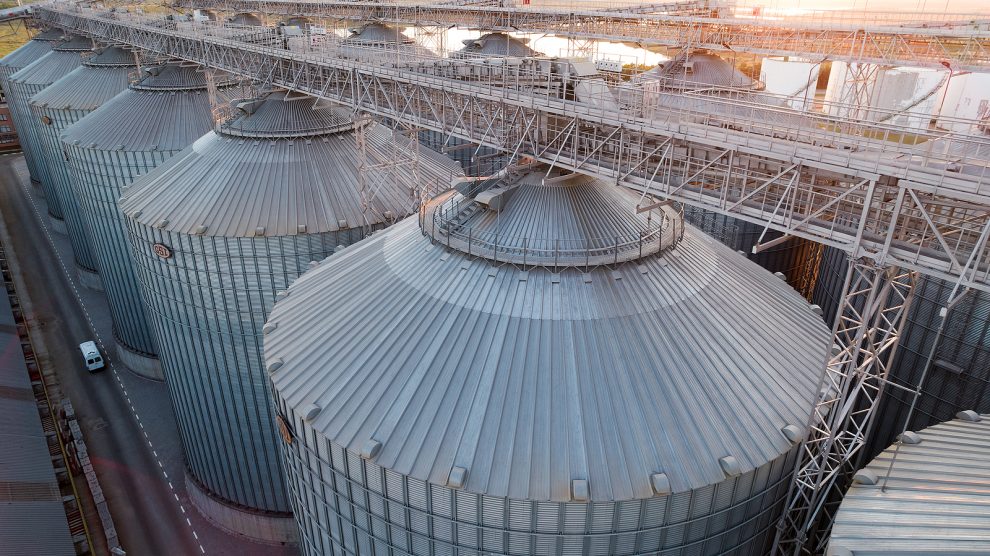Alternative export routes can only shift a small part of the grain Ukraine usually sends by sea to external markets.
Ukraine is currently unable to bring all its available grain stocks to external markets due to Russia’s ongoing blockade of the Black Sea. Unless the blockade is lifted, almost five million tonnes of wheat and nearly ten million tonnes of maize (corn) from the 2021 harvest will remain in storage, with no space for the 2022 harvest.
- UN issues new warning of global food shortage unless Russia unblocks Ukraine’s ports
- ‘By the book’: From here on in, Ukraine and Moldova should expect no special treatment from the EU
- Assessing the environmental impact of the war in Ukraine
Since the start of the war Ukraine has been totally blocked from the north, east and south. The only remaining channel for exporting and importing commodities are land routes through our western border.
While alternative transshipment capacities could be expanded in the mid-term (three-five years), in the immediate future there is no alternative except to unblock Ukraine’s seaports.
For several decades Ukrainian businesses have been investing heavily into seaports transshipment capacities. Seaport infrastructure was well-developed and until the start of new Russian aggression on February 24, nearly 75 per cent of all commodity turnover in tonnage was flowing through the seaports.
Land transshipment capacities at the western border fall far short. Railway capacity allows nearly 0.6 million tonnes of grain exports per month while the minimum capacity needed to bring all available agro-commodities for exports is five million tonnes per month.
The main problem with transporting grain via rail is the difference in gauge between post-Soviet countries and the rest of the Europe. Rail wagons loaded with grain in Ukraine cannot pass freely to Poland or Romania because the wheels of the wagons do not match the railway tracks in those countries. The grain therefore needs to be re-loaded onto wagons that can use Polish railway infrastructure, increasing costs.
Threat of hunger
The threat of hunger in some countries, as well as the critical need for fresh export proceeds for Ukraine itself is pushing officials to search for new ways of exporting grain.
The acting head of Ukrzaliznytsya, the state railway company, Oleksandr Kamyshin, says that Ukrzaliznytsya has expanded transshipment capacities up to 0.8 million tonnes per month (from 0.6 million tonnes) and that this is the upper possible limit for now.
There might be some extra room to expand capacity by transporting grain in containers in order to simplify the process of re-loading, while transporting grain via river routes to Danube ports is another option Ukraine is currently exploiting.
According to Mr Kamyshin, nearly 40-50 per cent of exports are currently going via rail, 35-40 per cent through Danube ports and 10-15 per cent by road.
State officials claim it is impossible to rebuild railway tracks in Ukraine even in the mid-term future. What’s more, it’s not only the track width that is a problem but also the old wagons, which need be changed – this will not happen any time soon.
What could be done is to increase of the number of checkpoints at the western border for road transportat and the expansion of transshipment capacity at available checkpoints. But this process also requires time and investment.
No alternative
To make matters worse, the seaports in Romania, Poland and Baltic states do not have much reserve capacity for Ukrainian grain. It may be possible to export some grain through these ports before the 2022 harvest from other European countries arrives, but when the flow of fresh crops begins arriving, seaports in Romania, Poland and the Baltic states will face difficulties finding room for the Ukrainian harvest.
According to the acting head of Ukrzaliznytsya, the seaports of Romania might accept up to 0.3 million tonnes per month, Poland and Germany up to 0.7 million tonnes per month jointly, and the Baltic states one million tonnes per month. This is well short of capacity Ukraine needs.
On Ukraine’s western border, for now only 1.5 million tonnes of grain per month can get through, and even after all the upgrades are finished capacity will be two million tonnes maximum, according to Mr Kamyshin.
In the immediate future there is simply no alternative route to the unblocking of Ukrainian seaports.
In the medium-term, perhaps two-three years, the situation might change, but it’s not clear why Romania, Poland and the Baltic states would invest in the expansion of their capacity given that the need for alternative routes for Ukrainian grain might be temporary and short-lived.
Unlike many news and information platforms, Emerging Europe is free to read, and always will be. There is no paywall here. We are independent, not affiliated with nor representing any political party or business organisation. We want the very best for emerging Europe, nothing more, nothing less. Your support will help us continue to spread the word about this amazing region.
You can contribute here. Thank you.








Add Comment